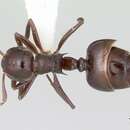en
names in breadcrumbs


I have only three records of C. distans from Costa Rica: two older museum collections from the Central Valley, and one collection from La Selva Biological Station in the Atlantic lowlands. It is clear from material elsewhere in the range of the species that distans prefers seasonally dry, open or brushy habitats.
In general, distans has very large colonies that are low density. The one La Selva collection I observed was from a recent treefall. A large dead trunk had fallen, bringing a large Bauhinia vine tangle down with it. Crematogaster distans dominated the treefall, with columns of abundant workers spread throughout and streaming back to the canopy along lianas. I did not find any nest center or brood, but I did find two alate queens along with a worker aggregation in a hollow stick. In the Santa Marta region of Colombia I observed a distans nest in a dead stick, and on another occasion I found workers tending Coccoidea on Cnidoscolus (Euphorbiaceae). In a second growth forest in Venezuela I observed columns of workers descending a tree trunk and spreading out onto an Inga sapling, where large numbers of workers were tending scale insects.
Nothing is known of colony founding, but queens exhibit a morphology often associated with social parasitism. Kusnezov (1949) described descolei from a single alate queen and suggested that it was a workerless social parasite because of the small size and shiny integument. Kempf (1968) refuted this by reporting worker-associated colonies. The discovery of a colony of distans at La Selva with queens identical to descolei confirmed the synonymy of descolei under distans. It is possible that Crematogaster distans is a temporary social parasite, requiring colonies of host species to establish new colonies of its own, but it is not workerless.
The species complex occurs from southern USA (Texas) to Argentina (see Comments).
Taxonomic history
Kempf, 1968b PDF: 392 (q.).Combination in Crematogaster (Orthocrema): Emery, 1922c PDF: 134.Combination in Crematogaster (Neocrema): Santschi, 1918d PDF: 182; Kempf, 1972b PDF: 83.Combination in Crematogaster (Orthocrema): Blaimer, 2012c PDF: 55.Senior synonym of Crematogaster distans cordinoda: Kempf, 1968b PDF: 390.Senior synonym of Crematogaster distans paraensis: Kempf, 1968b PDF: 390.Senior synonym of Crematogaster distans parviceps: Kempf, 1968b PDF: 390.Senior synonym of Crematogaster distans pevsnerae: Kempf, 1968b PDF: 390.Senior synonym of Crematogaster distans vanda: Kempf, 1968b PDF: 390.Senior synonym of Crematogaster descolei: Longino, 2003a PDF: 59.